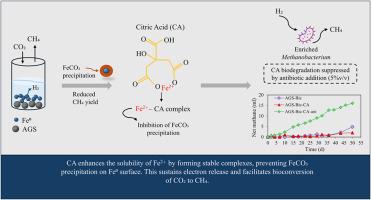柠檬酸的双重作用:促进CO2向CH4的生物转化,提高零价铁的生物利用度
IF 8.4
2区 环境科学与生态学
Q1 ENVIRONMENTAL SCIENCES
引用次数: 0
摘要
利用Fe0将CO2转化为CH4的研究报道了部分CO2转化为FeCO3,在Fe0表面形成钝化层,降低了其反应性,限制了工艺效率。为了减轻FeCO3沉淀并增强Fe0对CO2-to-CH4的转化,本研究评估了柠檬酸(CA)作为Fe2+配体的作用,该配体有助于维持铁的可溶性形式,并防止其快速转化为不溶性碳酸铁(FeCO3)。在30 mM Fe0、厌氧颗粒污泥(AGS)和以CA为配体的NaHCO3条件下进行的批量实验表明,柠檬酸盐可降解为乙酸和CO2气体。为了防止柠檬酸盐降解并阐明其对fe0介导的甲烷生成的影响,以5% v/v的抗生素抗真菌溶液(100x)(10,000单位青霉素,10 mg链霉素和25 μg两性霉素/ ml)为研究工具,选择性地抑制细菌活性,而不影响氢营养产甲烷菌。只有添加了NaHCO3、CA、抗生素和Fe0的样品甲烷产量才显著增加,到第50天甲烷产量达到38 ml,而不添加Fe0的样品甲烷产量仅为22 ml,净甲烷产量为16 ml。结果表明,CA通过维持铁的溶解度和抑制FeCO3的沉淀来促进甲烷的产量,从而促进铁的持续氧化和持续的电子释放,从而支持微生物将CO2还原为CH4。虽然抗生素提供了一个可控的环境来揭示这些机制,但它们的使用并不是一个可行的长期解决方案。基于这项研究的发现,未来的工作可能会探索短期CA暴露(12小时)或替代配体,以减少生物降解,而不依赖抗生素。本文章由计算机程序翻译,如有差异,请以英文原文为准。

Dual role of citric acid: facilitate the bioconversion of CO2 to CH4 and enhance bioavailability of zero-valent iron
Studies on the bioconversion of CO2 to CH4 using Fe0 have reported that a fraction of CO2 is converted to FeCO3, forming a passivation layer on the Fe0 surface, which reduces its reactivity and limits process efficiency. To mitigate FeCO3 precipitation and enhance CO2-to-CH4 conversion using Fe0, this study evaluates the role of citric acid (CA) as a ligand to Fe2+, which helps maintain iron in a soluble form and prevents its rapid conversion to insoluble iron carbonate (FeCO3). Batch experiments with 30 mM Fe0, anaerobic granular sludge (AGS), and NaHCO3 with CA as a ligand showed that citrate biodegraded into acetic acid and CO2 gas. To prevent citrate degradation and elucidate its effect on Fe0-mediated methanogenesis, 5 % v/v of antibiotic antimycotic solution (100x) (10,000 units penicillin, 10 mg streptomycin and 25 μg amphoctericin per ml) were introduced as a research tool, selectively inhibiting bacterial activity without affecting hydrogenotrophic methanogens. Methane production was notably enhanced only in the sample with NaHCO3, CA, antibiotics, and Fe0, reaching 38 ml by day 50, whereas the corresponding sample without Fe0 produced only 22 ml, resulting in a net methane production of 16 ml. The results indicate that CA enhances methane production by maintaining iron solubility and inhibiting FeCO3 precipitation, thereby facilitating continuous iron oxidation and sustained electron release, which supports the microbial reduction of CO2 to CH4. While antibiotics provided a controlled environment to uncover these mechanisms, their use is not a viable long-term solution. Based on the findings of this study, future work may explore short-term CA exposure (<12 h) or alternative ligands to minimize biodegradation without relying on antibiotics.
求助全文
通过发布文献求助,成功后即可免费获取论文全文。
去求助
来源期刊

Journal of Environmental Management
环境科学-环境科学
CiteScore
13.70
自引率
5.70%
发文量
2477
审稿时长
84 days
期刊介绍:
The Journal of Environmental Management is a journal for the publication of peer reviewed, original research for all aspects of management and the managed use of the environment, both natural and man-made.Critical review articles are also welcome; submission of these is strongly encouraged.
 求助内容:
求助内容: 应助结果提醒方式:
应助结果提醒方式:


